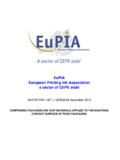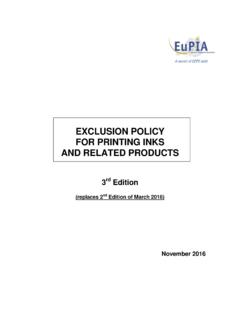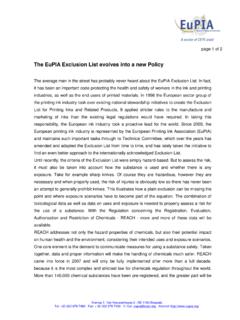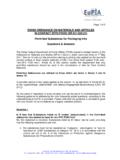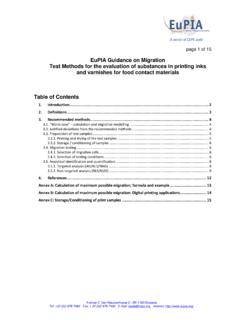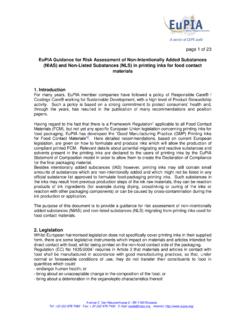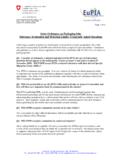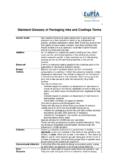Transcription of EuPIA Guideline on Printing Inks applied to Food Contact ...
1 EuPIA Guideline on Printing Inks applied to Food Contact Materials April 2020 (This document replaces the November 2011/July 2012 corrigendum version. It reflects the advancements of EuPIA s consumer safety and compliance concepts as the current state of the art) 1. Introduction and EuPIA commitments EuPIA member companies have for many years shown strong commitments related to the manufacture and supply of Printing inks for food Contact materials (hereafter called FCM inks ). Amongst these commitments there is the principle of placing consumer safety first, the principle of transparency and information sharing and the principle of implementing Good Manufacturing Practices. In order to demonstrate to external audiences that they are committed to the principles of protecting food consumer safety within the areas under their control, EuPIA member companies have been offered the opportunity to sign Compliance Commitments related to the manufacture and supply of FCM inks.
2 A list of signatories is available on the EuPIA website ( ) in the section: key topics food Contact materials. Operating on the basis of these commitments has been and still is highly important especially since there is not yet any specific european Union legislation concerning FCM inks. The EU Framework Regulation (EC) No 1935/2004 is the legal basis for FCM inks resp. printed food Contact materials. EuPIA assists its members to meet their commitments by issuing a number of guidance documents which members are encouraged to implement to ensure legal compliance and safeguarding consumer safety when formulating, manufacturing and marketing Printing inks for food Contact materials. This new edition of the EuPIA Guideline on Printing inks for food Contact materials gives a systematic overview of these guidance documents. 2. Field of Application This Guideline applies to Printing inks within the meaning of section 3, applied to a material that is in Contact with food; this includes both direct food Contact (DFC) and non-direct food Contact inks (non-DFC).
3 Inks to be printed on food Contact materials, for which migration of ink ingredients from the print layer to the food is impossible and set-off or gas phase transfer can be excluded, are not in the scope of this Guideline . page 2 of 6 3. Definitions Printing inks are: a. Mixtures of colourants with other substances which are applied on materials to form a graphic or decorative design together with or without b. other coloured or uncoloured overprint varnishes/ coatings or primers which are normally applied in combination with a) in order to enable the printed design to achieve specific functions such as ink adhesion, rub resistance, gloss, slip/friction, durability, etc. Printing inks do not include coatings which are applied with the prime objective of enabling the material or article to achieve a technical function such as heat sealing, barrier, corrosion resistance etc., as opposed to a graphic effect, even though they may be coloured. 4. Legislation on printed Food Contact Materials and its interpretation by EuPIA Whilst european harmonised legislation does not specifically cover food packaging inks in their supplied form, there are some legislative instruments which impact on materials and articles intended for direct Contact with food, whilst being printed on the non-food- Contact side.
4 Amongst those are the Framework Regulation (EC) No 1935/2004, Regulation (EC) No 2023/2006 setting out rules on Good Manufacturing Practice, the Plastics Regulation (EU) No 10/2011 and the corresponding Union Guidance on Regulation (EU) 10/2011 . Switzerland not being an EU member has issued a specific legislation on Printing inks applied to the non-food Contact surface of food Contact materials being part of the Swiss Ordinance on Food Contact Materials, known as Swiss Ordinance on Printing Inks which came into force in April 2010. Being the first ever specific regulation on Printing inks for food Contact materials on the globe it became a global reference in the supply chain. There are no legal implications though from the Swiss Ordinance in EU member states and therefore this Guideline will not make any further reference to the Swiss legislation. 5. Producing and Marketing Inks for Food Contact Materials: Good Manufacturing Practice (GMP) Printing Inks for Food Contact Materials Article 3 of the Framework Regulation, in connection with the GMP Regulation 2023/2006 stipulates that food Contact materials must be manufactured according to Good Manufacturing Practice.
5 The EuPIA GMP sets out the specific obligations for Printing ink manufacturers. Following the EuPIA GMP ensures compliance with the basic requirements of Article 3 of the framework regulation and the GMP regulation. The EuPIA GMP shall assist in controlling food safety hazards in the design and manufacture of FCM inks. It applies for products either formulated to be used on the non-food Contact surface or food Contact surface of food Contact materials and articles. The GMP includes requirements on product composition, quality and hygiene management and covers the entire process from raw material supply, ink formulation, ink manufacturing, packaging and transport. EuPIA s GMP is composed in a way, that it is auditable by external parties. page 3 of 6 european Printing Ink association EuPIA - a sector of CEPE aisbl Boulevard du Triomphe 172 1160 Brussels, BELGIUM T +32 2 897 20 20 6. General requirements and Raw Material Selection criteria for FCM Inks Raw materials are either substances or mixtures, and will usually contain Non-Intentionally Added Substances (NIAS) as impurities.
6 EuPIA members carefully select the raw materials to be used in FCM inks in order to meet the existing legal requirements. The selection criteria can be found in the Addendum. Dealing with Non-Intentionally Added Substances (NIAS) and Non-Listed Substances in raw materials (NLS) Non-Intentionally Added Substances (NIAS) play an important role in the Food Safety discussion. They are present either as impurities in raw materials used in FCM inks or can be formed during manufacturing or conversion processes. In case these NIAS are potential migrants they need to be properly risk assessed. The use of Non-Listed Substances in raw materials is only allowed, when a risk assessment results in compliance with the Framework Regulation requirements. EuPIA has issued a document called EuPIA Guidance for Risk Assessment of Non-Intentionally Added Substances (NIAS) and Non-Listed Substances (NLS) in Printing inks for food Contact materials. 7. Further important tools and documents ensuring compliance along the supply chain Statements of Composition (SoC) Transparency and information sharing along the supply chain is key.
7 To that end EuPIA has developed a model document, called Statement of Composition (SoC) meant to give detailed information on potential migrants present in a FCM ink. This document shall be easily available or accessible for each FCM ink supplied to converters. It shall enable the converter to assume his part of compliance work whilst concluding on the migration risk from his ready made packaging. In the case of a SoC intended to cover a group of products, it must include all migrants coming from the individual formulations in the group. Technical Data Sheets (TDS) or similar Technical Information The Technical Data Sheet is another important document to be shared with the converter. It shall be easily available or accessible for each FCM ink supplied to converters. It shall inform the converter about the appropriate use of the FCM ink, whether suitable (only) for the non-food Contact surface of FCM or for intentional direct Contact with food. Furthermore, it shall inform about application and conversion details as well as about potential restrictions as regards heat or storage time.
8 Page 4 of 6 Guidance on migration testing In the case that worst-case calculations, migration modelling and further refinement with EFSA food consumption data would prove not to be sufficient in order to exclude a migration risk, real migration testing is the only option. There are however some important specifics which have to be observed when testing printed FCM on migration. To this end EuPIA has published comprehensive Guidance on migration testing methods. Supplier information on raw materials In order to safeguard legal compliance as well as consumer safety it is paramount to have detailed knowledge about identity of raw materials often coming as mixtures and in the majority of cases carrying impurities from the production process, many of them being categorized as NIAS. In order to get utmost and detailed information on the composition of each raw material used in FCM inks EuPIA has concluded on a Regulatory Questionnaire for FCM Printing Ink Raw Materials as internal guidance for its members.
9 This shall underline the paramount need for detailed information on the composition of the raw materials. Guidance on specific ink technologies: UV for FCM EuPIA has issued guidance to its members for appropriate raw materials uses for UV FCM inks, the Suitability List of Photo-Initiators and Photosynergists for FCM. The suitability list provides proper guidance for the ink formulator on adequate photoinitiator choices, which are a basis for compliant UV FCM prints. PIFOOD, 21 April 2020 page 5 of 6 european Printing Ink association EuPIA - a sector of CEPE aisbl Boulevard du Triomphe 172 1160 Brussels, BELGIUM T +32 2 897 20 20 Addendum to the EuPIA Guideline General requirements/Raw Material Selection Criteria 1. General requirements for FCM inks: Exclusion criteria: Following the general exclusion criteria as laid down in the EuPIA Exclusion Policy for Printing Inks and Related Products Recommendations The use of mineral oil-based raw materials in FCM inks is not In some raw materials small amount of mineral oil may be present as impurity or residual from production steps.
10 In such cases it needs to be ensured, that the inks do not significantly contribute to the mineral oil content in the packaging material. The use of triarylmethane ( fanal ) pigments for FCM application is strongly not recommended. These pigments have a strong tendency for migration and should be only used if migration into the food is not possible. General purity requirements for FCM inks: Minimize content of Nonylphenols, other alkylphenols (C5 C9 alkyl chain) and in general alkylphenol ethoxylates (APEO s) (indicative maximum limit: 50 ppm in FCM ink). Minimize content of Acetylacetone (123-54-6) releasing substances, especially of Titanium Acetylacetonate, CAS 17927-72-9 (indicative maximum limit: 50 ppm in FCM ink) due to the recognized genotoxic potential. Following specific metal restrictions expressed as migration limit as outlined in Annex II of (EU) No 10/2011 for Al, Ba, Cu, Fe, Li, Mn, Ni, Zn, Sb, B, Cd, Cr, Co, Pb, Hg, Sn, As, La, Tb, Gd, Li, Eu, Fe.
